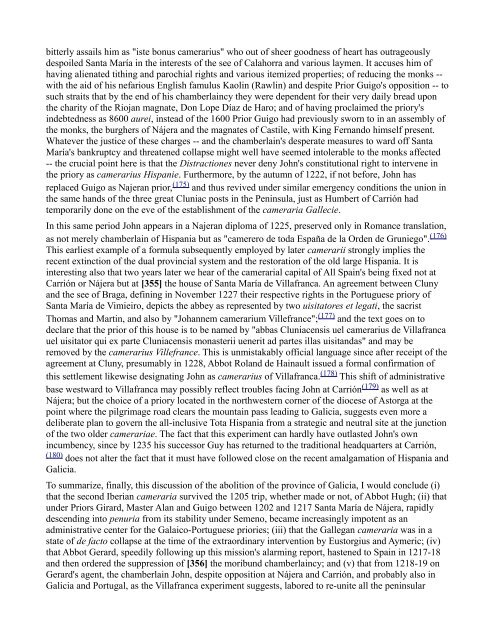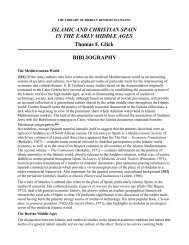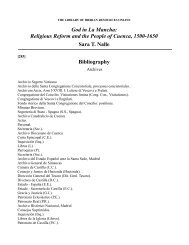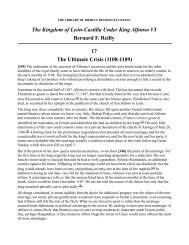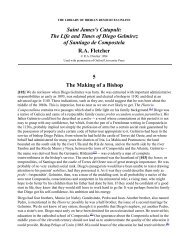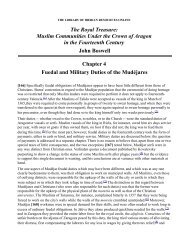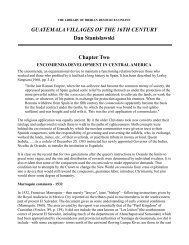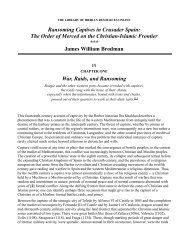The Cluniac Priories of Galicia and Portugal - The Library of Iberian ...
The Cluniac Priories of Galicia and Portugal - The Library of Iberian ...
The Cluniac Priories of Galicia and Portugal - The Library of Iberian ...
You also want an ePaper? Increase the reach of your titles
YUMPU automatically turns print PDFs into web optimized ePapers that Google loves.
itterly assails him as "iste bonus camerarius" who out <strong>of</strong> sheer goodness <strong>of</strong> heart has outrageously<br />
despoiled Santa María in the interests <strong>of</strong> the see <strong>of</strong> Calahorra <strong>and</strong> various laymen. It accuses him <strong>of</strong><br />
having alienated tithing <strong>and</strong> parochial rights <strong>and</strong> various itemized properties; <strong>of</strong> reducing the monks --<br />
with the aid <strong>of</strong> his nefarious English famulus Kaolin (Rawlin) <strong>and</strong> despite Prior Guigo's opposition -- to<br />
such straits that by the end <strong>of</strong> his chamberlaincy they were dependent for their very daily bread upon<br />
the charity <strong>of</strong> the Riojan magnate, Don Lope Díaz de Haro; <strong>and</strong> <strong>of</strong> having proclaimed the priory's<br />
indebtedness as 8600 aurei, instead <strong>of</strong> the 1600 Prior Guigo had previously sworn to in an assembly <strong>of</strong><br />
the monks, the burghers <strong>of</strong> Nájera <strong>and</strong> the magnates <strong>of</strong> Castile, with King Fern<strong>and</strong>o himself present.<br />
Whatever the justice <strong>of</strong> these charges -- <strong>and</strong> the chamberlain's desperate measures to ward <strong>of</strong>f Santa<br />
María's bankruptcy <strong>and</strong> threatened collapse might well have seemed intolerable to the monks affected<br />
-- the crucial point here is that the Distractiones never deny John's constitutional right to intervene in<br />
the priory as camerarius Hispanie. Furthermore, by the autumn <strong>of</strong> 1222, if not before, John has<br />
replaced Guigo as Najeran prior, (175) <strong>and</strong> thus revived under similar emergency conditions the union in<br />
the same h<strong>and</strong>s <strong>of</strong> the three great <strong>Cluniac</strong> posts in the Peninsula, just as Humbert <strong>of</strong> Carrión had<br />
temporarily done on the eve <strong>of</strong> the establishment <strong>of</strong> the cameraria Gallecie.<br />
In this same period John appears in a Najeran diploma <strong>of</strong> 1225, preserved only in Romance translation,<br />
as not merely chamberlain <strong>of</strong> Hispania but as "camerero de toda España de la Orden de Gruniego". (176)<br />
This earliest example <strong>of</strong> a formula subsequently employed by later camerarii strongly implies the<br />
recent extinction <strong>of</strong> the dual provincial system <strong>and</strong> the restoration <strong>of</strong> the old large Hispania. It is<br />
interesting also that two years later we hear <strong>of</strong> the camerarial capital <strong>of</strong> All Spain's being fixed not at<br />
Carrión or Nájera but at [355] the house <strong>of</strong> Santa María de Villafranca. An agreement between Cluny<br />
<strong>and</strong> the see <strong>of</strong> Braga, defining in November 1227 their respective rights in the Portuguese priory <strong>of</strong><br />
Santa María de Vimieiro, depicts the abbey as represented by two uisitatores et legati, the sacrist<br />
Thomas <strong>and</strong> Martin, <strong>and</strong> also by "Johannem camerarium Villefrance"; (177) <strong>and</strong> the text goes on to<br />
declare that the prior <strong>of</strong> this house is to be named by "abbas <strong>Cluniac</strong>ensis uel camerarius de Villafranca<br />
uel uisitator qui ex parte <strong>Cluniac</strong>ensis monasterii uenerit ad partes illas uisit<strong>and</strong>as" <strong>and</strong> may be<br />
removed by the camerarius Villefrance. This is unmistakably <strong>of</strong>ficial language since after receipt <strong>of</strong> the<br />
agreement at Cluny, presumably in 1228, Abbot Rol<strong>and</strong> de Hainault issued a formal confirmation <strong>of</strong><br />
this settlement likewise designating John as camerarius <strong>of</strong> Villafranca. (178) This shift <strong>of</strong> administrative<br />
base westward to Villafranca may possibly reflect troubles facing John at Carrión (179) as well as at<br />
Nájera; but the choice <strong>of</strong> a priory located in the northwestern corner <strong>of</strong> the diocese <strong>of</strong> Astorga at the<br />
point where the pilgrimage road clears the mountain pass leading to <strong>Galicia</strong>, suggests even more a<br />
deliberate plan to govern the all-inclusive Tota Hispania from a strategic <strong>and</strong> neutral site at the junction<br />
<strong>of</strong> the two older camerariae. <strong>The</strong> fact that this experiment can hardly have outlasted John's own<br />
incumbency, since by 1235 his successor Guy has returned to the traditional headquarters at Carrión,<br />
(180)<br />
does not alter the fact that it must have followed close on the recent amalgamation <strong>of</strong> Hispania <strong>and</strong><br />
<strong>Galicia</strong>.<br />
To summarize, finally, this discussion <strong>of</strong> the abolition <strong>of</strong> the province <strong>of</strong> <strong>Galicia</strong>, I would conclude (i)<br />
that the second <strong>Iberian</strong> cameraria survived the 1205 trip, whether made or not, <strong>of</strong> Abbot Hugh; (ii) that<br />
under Priors Girard, Master Alan <strong>and</strong> Guigo between 1202 <strong>and</strong> 1217 Santa María de Nájera, rapidly<br />
descending into penuria from its stability under Semeno, became increasingly impotent as an<br />
administrative center for the Galaico-Portuguese priories; (iii) that the Gallegan cameraria was in a<br />
state <strong>of</strong> de facto collapse at the time <strong>of</strong> the extraordinary intervention by Eustorgius <strong>and</strong> Aymeric; (iv)<br />
that Abbot Gerard, speedily following up this mission's alarming report, hastened to Spain in 1217-18<br />
<strong>and</strong> then ordered the suppression <strong>of</strong> [356] the moribund chamberlaincy; <strong>and</strong> (v) that from 1218-19 on<br />
Gerard's agent, the chamberlain John, despite opposition at Nájera <strong>and</strong> Carrión, <strong>and</strong> probably also in<br />
<strong>Galicia</strong> <strong>and</strong> <strong>Portugal</strong>, as the Villafranca experiment suggests, labored to re-unite all the peninsular


